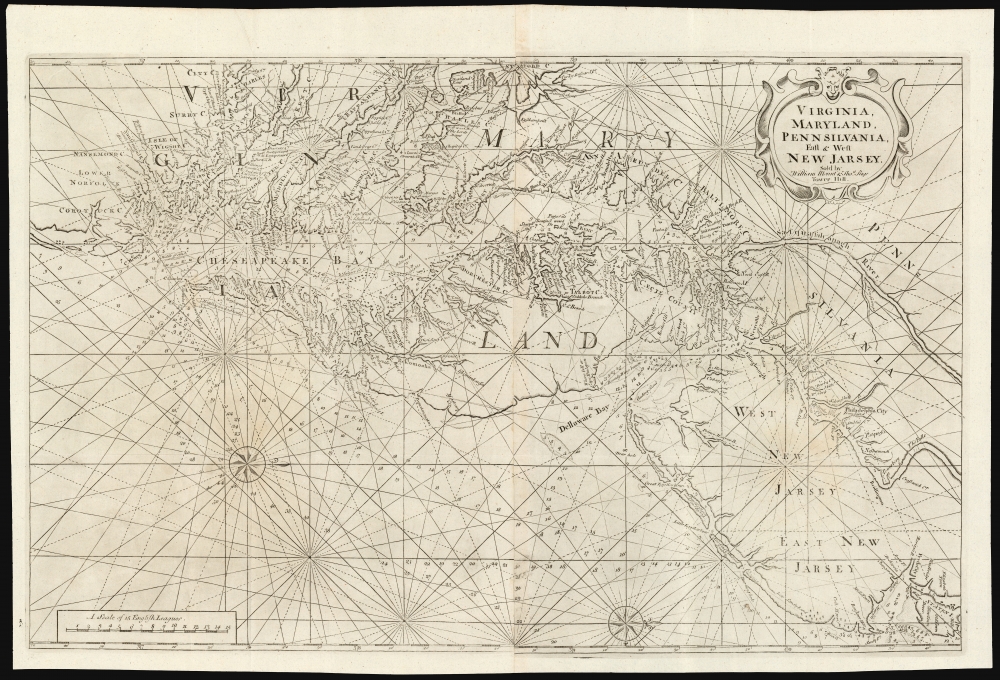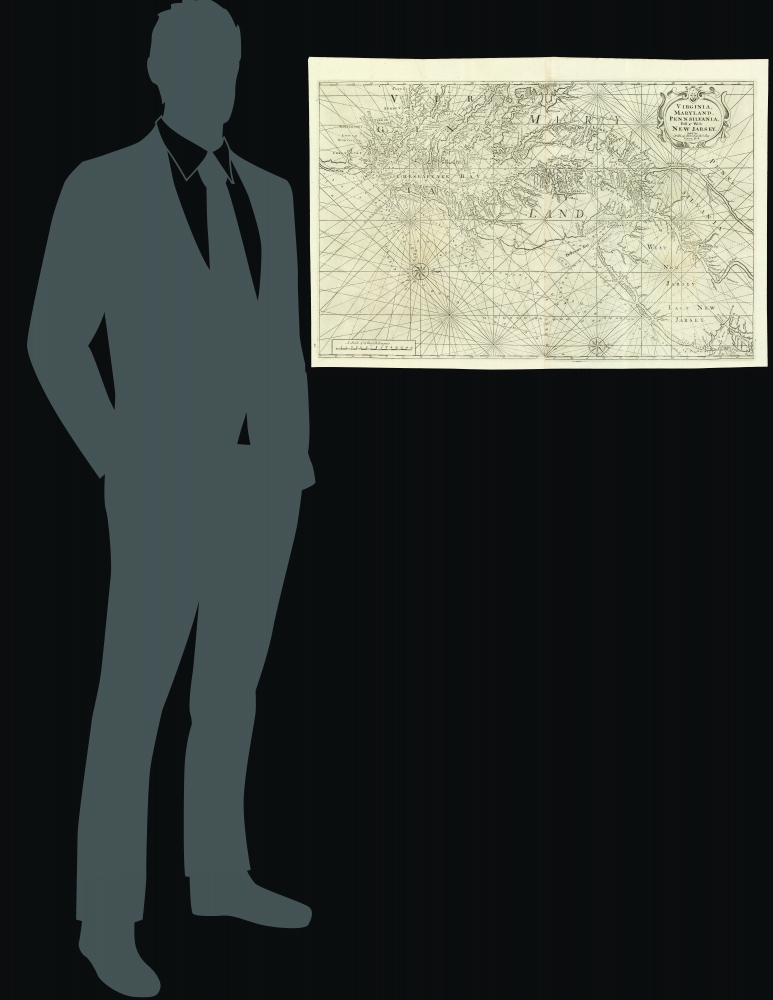1742 William Mount and Thomas Page Nautical Chart of Chesapeake Bay
Chesapeake-mountpage-1742
Title
1742 (undated) 19.75 x 31.25 in (50.165 x 79.375 cm) 1 : 600000
Description
A Closer Look
The map's basic outline was derived from Augustine Hermann's 1673 Virginia and Maryland. Coolie Verner considered Thornton's Virginia chart 'a careful and exact copy of the Herman (sic)', but it was augmented in the north from other sources, as were its array of depth soundings and shoals. The westward-oriented chart covers the mid-Atlantic coast, from Staten Island to Virginia Beach. It includes the lower reaches of the Susquehanna and Delaware Rivers. The Potomac is depicted as far as what is here termed Turkey Buzzard Point. Not to be mistaken for the modern peninsula of that name on the Patuxent River, Turkey Buzzard Point was later shortened to Buzzard Point, which overlooks the juncture of the Potomac and Anacostia Rivers and constitutes the southernmost tip of present-day Washington, D.C.While it does identify the colonies, and names the counties within them, as a chart the work is focused on waterways and does not include detail of the interior, such as cities and roads. The chart is abundantly marked with rhumb lines and depth soundings and sports two elegant compass roses.
Publication History and Census
Initially engraved in 1689 by John Thornton, for inclusion in his Atlas Maritimus. After a long run in that nautical atlas, the plate passed to Mount and Page just prior to Thornton's death in 1707-8, after which they began to publish the chart in their The English Pilot. The age of the plates necessitated their re-engraving to two new ones in and around 1742. The easiest point of recognition for these second plate examples is the lettering 'VIR GIN IA' for that colony's name. Coolie Verner's cartobibliography of the Virginia maps appearing in The English Pilot enumerates two states for the second plate of the chart. The 1773 second state of the second plate exhibited the changed spelling of the place name 'Jarsey' to 'Jersey' as well as sporting a longer tail in the 'g' of Page's imprint. The spelling 'Jarsey' appearing on this example, as well as the long tail of the 'g', identifies this as the first state of the second plate. Examples of this version of the map were included in editions of The English Pilot from 1743 to 1770. The English Pilot is well represented in institutional collections, but we see just four separate examples of this state of the chart in OCLC.CartographerS
John Thornton (October 8, 1641 - January 23, 1708) was a British chartmaker, sea captain, publisher and engraver active in London during the late 18th and early 19th centuries. Thornton apprenticed to John Burston where mastered the art of manuscript maritime cartography as practiced by the Thames School. By the 1660s Thornton, working with John Seller and William Fisher, began publishing printed nautical charts and was the only Thames School cartographers to successfully transition to print. Thornton published numerous maps both independently and with some of the most prominent British publishers of his day, including the aforementioned as well as Herman Moll, Robert Morden, James Clark, Robert Greene, and Philip Lea. From around 1665 Thornton took over from Seller the production of the English Pilot. Upon his death in 1708 Thornton willed his charts, copper plates, instruments, and 'all things belonging to my calling' to his son, Samuel Thornton, who continued to republished his father's work, with few updates, until about 1715. More by this mapmaker...
Mount and Page (fl. 1701 - 1760) was a London based firm of religious and maritime publishers that flourished in the 18th century. With the publication of the 1732 English Pilot, the Mount and Page name became well-known worldwide as an imprint of nautical charts. The firm was founded at Tower Hill, London, in 1701 by Richard Mount (1654 - 1722) and his apprentice Thomas Page (1780 - March 15, 1733). Mount had previously been in partnership with his father-in-law William Fisher (1631 - 1691) and inherited the business on the latter's death. Page completed his apprenticeship in 1716. Now fully partnered, Mount and Page subsequently acquired the map plates several defunct British nautical chart publishers, including Greenville Collins, Jeremiah Seller, Charles Price, and John and Samuel Thornton - thus nearly monopolizing the British nautical chart business. The firm consequently received several lucrative government contracts and thereby flourished throughout the 18th century, making the fortunes of both families. Successive generations of Mounts and Pages worked in the business, and the families intermarried. Its staple titles were The English Pilot and Navigatio Britannica by John Barrow. By the 1760s, Richard Mount's grandson John Mount (1725 - 1786) was able to retire to Berkshire where he built the stately mansion, Wasing Place. John's son William (1753 - 1815) was the last to work in the map business, and later generations went into politics. Learn More...




